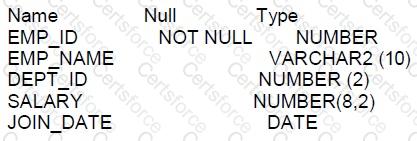Which two statements are true about selecting related rows from two tables based on entity relationship diagram (ERD)?
Which two statements are true about the rules of precedence for operators?
Examine the description of the CUSTOMERS table:
Which three statements will do an implicit conversion?
Which three statements are true about GLOBAL TEMPORARY TABLES?
Examine the description of the CUSTONERS table:

CUSTNO is the PRIMARY KEY.
You must determine if any customers' details have been entered more than once using a different CUSTNO, by listing all duplicate names.
Which two methods can you use to get the required result?
Which statement will return a comma-separated list of employee names in alphabetical order for each department in the EMP table?
Examine the description of the EMPLOYEES table:

NLS_DATE_FORMAT is set to DD-MON-YY.
Which query requires explicit data type conversion?
The CUSTOMERS table has a CUST_CREDT_LIMIT column of data type number.
Which two queries execute successfully?
Examine this statement:

Which two things must be changed for it to execute successfully?
Examine these statements and results:
SQL> SELECT COUNT(*) FROM emp
COUNT(*)
---------------------
14
sQL> CREATE GLOBAL TEMPORARY TABLE t emp As SELECT * FROM emp;
Table created
SQL> INSERT INTo temp SELECT * FROM emp;
14 rows created
SQL> COMMIT:
Commit complete*
SQL> INSERT INTo temp SELECT * EROM emp;
14. rows created
SQL> SELECT COUNT(*) FROM t emp
How many rows are retrieved by the last query?